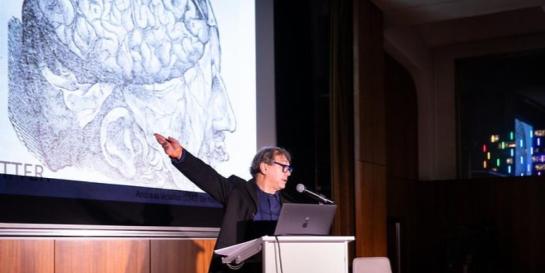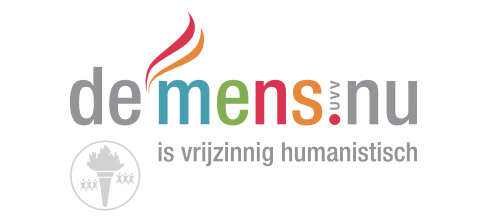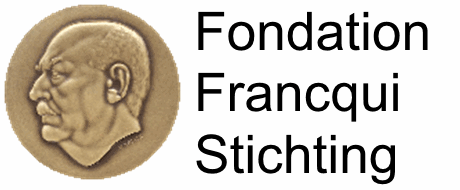Willy Calewaert Leerstoel Prof. Dr. Em. Luc STEELS

19 december 2023, 19-22, KBR
Fundamenteel onderzoek in AI vandaag: Inaugurale lezing
In het kader van het veertigjarige bestaan van het VUB AI Lab verzorgt oprichter Luc Steels op dinsdag 19 december 2023 de inaugurale lezing van de Leerstoel Willy Calewaert. Onder de titel ‘Fundamenteel onderzoek in AI vandaag’, zal hij de huidige stand van zaken betreffende AI in ogenschouw nemen en pleiten voor een mensgerichte AI die betekenis, waarheid, begrip, taal, normen en waarden centraal stelt.
18-23 december 2023, doorlopend, KBR
Tentoonstelling: Wetenschap aan de rand van chaos. De AI avant-garde in de jaren tachtig en negentig
Vanaf 18 december 2023 kan je in de Koninklijke Bibliotheek van België terecht voor een boeiende pop-up tentoonstelling over de AI avant-garde in de jaren tachtig en negentig. Toen werden onderzoekers in de voorhoede van kunstmatige intelligentie en kunstmatig leven meegesleept door de opkomst van een nieuwe wetenschap van complexe systemen die uiteenlopende verschijnselen als tornado’s en crashes op de aandelenmarkt beschouwde als zelforganiserende dynamische systemen. De tentoonstelling werd gecureerd door Europees AI-pionier en VUB-professor Luc Steels.
7 maart 2024, 15-17, K.2.55
De geboorte van AI (1950-1990)
Waar liggen de wortels van AI? We gaan terug naar de jaren 50' en bekijken de bijdragen van de eerste grondleggers: Claude Shannon, Grey Walter, Alan Turing, Marvin Minsky, e.a. In de jaren 50' zien we al de eerste neurale netwerken verschijnen en ook de eerste symbolische AI programma's. Van dan begint de gestage opgang zowel op technologisch vlak, met onder meer AI programmeertalen zoals LISP, en nieuwe fundamentele doorbraken. Zij leiden tot de eerste golf van commerciele AI activiteiten in de jaren 80', vooral dan de ontwikkeling van kennissystemen. Vanaf 1983 is ook het VUB AI lab actief met kennissystemen voor allerlei industriele toepassingen. Ook die nemen we onder de loupe.
21 maart 2024, 15-17, E.0.04
Artificial Life en cognitieve robots (1985-2005)
Het verhaal van AI gaat verder met de opkomst van 'Artificial Life' en behavior-based robots op het einde van de jaren 80'. Het onderzoek verschuift van het bouwen van AI systemen naar het begrijpen hoe zo'n systemen zichzelf kunnen opbouwen en hoe intelligentie is kunnen evolueren. Er is een vernieuwde interesse voor cybernetica en neurale netwerken en diverse projecten om principes uit de biologie toe te passen (zoals selectie met genetische algoritmen). Deze ideeen werken niet alleen om gedragspatronen te leren maar ook voor de oorsprong en evolutie van taal. Ook hier gaan we kijken hoe het AI lab in de jaren 90' hier heeft bijgedragen via een aantal belangrijke experimenten.
8 november 2024, 14-17:30, G.1.52
Generatieve AI, belichaamd in systemen zoals ChatGPT, rolt nog steeds als een tsunami over de wereld met bijna dagelijks nieuwe systemen, nieuwe toepassingen, en een stijging in het aantal gebruikers in een groeiend aantal domeinen, incluis de natuurwetenschappen. De recente Nobel prijzen voor scheikunde en natuurkunde hebben alletwee te maken met AI. Maar ondanks al het enthousiasme kunnen we niet blind zijn voor de knagende limieten van generatieve AI. Aangezien neurale netwerken voor een groot stuk een zwarte doos zijn, is het moeilijk om hoogte te krijgen van wat een systeem wel of niet kan, en waar dingen mislopen en waarom. In dit seminarie komen AI specialisten aan het woord die hun vinger leggen op zwakke plekken van de populaire generatieve AI methoden. We stellen kritisch vragen, in het bijzonder: Kan AI problemen die redeneringen vergen oplossen? Kan AI echt taal begrijpen? Zijn er wiskundige limieten aan AI? Is AI nu al creatief of (nog) niet? Antwoorden op deze vragen zijn van belang voor iedereen die AI wil gebruiken. Ze zijn ook relevant voor AI onderzoekers die de grenzen van AI moeten verleggen en de technologie meer betrouwbaar maken.
De leerstoel wordt mogelijk gemaakt dankzij ondersteuning van demens.nu

Francqui Chair Prof. Dr. Stéphane JAFFARD
The Department of Mathematics and Data Science is pleased to invite you to the inaugural lecture of the Francqui Chair 2023-2024, awarded to Prof. Dr. Stéphane Jaffard from the Laboratory of Analysis and Applied Mathematics of the Paris-East Créteil University (UPEC). The lecture is entitled:
Detection and characterization of the singularities of functions
The lecture will take place on Thursday 28 March 2024 at 5 p.m. in Room D.0.07, VUB Main Campus Etterbeek, Pleinlaan 2, Elsene, and is followed by a reception. Participation is free, but registration is required. For more information and to register, please visit
The inaugural lecture will be followed by a mini-course taking place from 16-19 April 2024. More information can be found on the above webpage. Please contact andreas.debrouwere@vub.be if you would like to attend this mini-course.
You can find the slides and the recordings of the inaugural lecture and the mini-course here.
Francqui Chair Prof. Dr. Ann DOOMS
22/02/2022
Those Who Can Imagine Anything, Can Create the Impossible
Online Inaugurale Lezing Belgische Francqui Leerstoel aan de Universiteit Antwerpen:
Promotor: Prof. Jouke Verlinden (productontwikkeling)
De mens is van oudsher een maker. 3 miljoen jaar geleden ontwierpen we al gereedschap om problemen op te lossen. Dankzij de Babyloniërs en hun kleitabletten weten we dat we ook al 5000 jaar lang gereedschap maken dat niet meteen een fysiek object is: de wiskunde! "De kunst van het zekere", volgens Simon Stevin. "De taal waarin de natuur tot ons spreekt", volgens Galileo Galilei.
Het proberen oplossen van praktische problemen zorgt voor nieuwe wiskundige concepten, die op hun beurt uit pure nieuwsgierigheid verder worden uitgediept. Patronen worden gezocht, gevonden en bewezen. De kunst van het abstraheren geeft ons telkens opnieuw nieuwe inzichten en middelen waar we al dan niet onverwacht later weer de vruchten van plukken. De wiskundige gereedschapskist bevat enorme rekenkracht met onder meer neurale netwerken en generatieve algoritmen - zeer relevant voor de ontwerper van de toekomst.
"Wandel je mee langs toeristische trekpleisters en verborgen parels die onze huidige wereld vormgeven?"
Francqui Chair Prof. Dr. Leo STORME
INAUGURAL LECTURE
Monday, 19 April, 2021 - 18:00
With great pleasure we announce that Professor Dr. Leo Storme will take up the Francqui Chair at the Department of Mathematics and Data Science (WIDS), research group Digital Mathematics (DIMA), VUB.
Prof. Dr. Leo Storme is renowned for his research in the fields of Finite Geometry and Coding Theory. His research is focussed on geometrical structures that live in finite geometries. This includes arcs and caps in finite projective spaces, (partial) spreads and (partial) ovoids in finite generalized quadrangles and finite classical polar spaces, and blocking sets in projective planes. One common denominator in the study of these objects is the notion of stability. When studying combinatorial structures one of the fundamental questions is often how much a structure can be changed without losing its characteristic properties. The field of finite geometry intertwines naturally with coding theory, as arcs in projective spaces are equivalent with MDS codes, blocking sets in projective spaces can be used to construct linear codes meeting the Griesmer bound, and particular substructures in finite geometries can be used to construct LDPC codes. Many other direct links are present and exploited in the work of Leo Storme. He has been Laureate of the biennial mathematics prize (1992) and the Frans Van Cauwelaert prize (2001) of the Royal Flemish Academy of Belgium for Science and the Arts. He is full professor at Ghent University since 2006 and he has been Fellow of the Alexander von Humboldt Foundation in 2006.
FINITE GEOMETRY: PURE MATHEMATICS CLOSE TO PRACTICAL APPLICATIONS
In this talk, we present the basic concepts of finite geometry, and a number of its most important substructures.
Finite geometry is about geometries over finite fields. The simplest finite fields are the integers modulo a prime number, a class of finite fields everybody has already calculated with. For instance, calculating with the days of the week is actually calculating modulo 7.
Geometries can be defined over finite fields. Geometries arising in such a way consist of a finite number of objects: points, lines, planes, ..., hyperplanes. Within these finite geometries, interesting geometrical substructures are investigated.
Many of these substructures are investigated because of their intrinsic geometrical properties, but it turns out very nicely that some substructures are highly relevant for research problems in other mathematical areas, such as coding theory or cryptography, where also a number of problems can be translated into equivalent problems in finite geometry.
In this talk, we demonstrate that finite geometry and coding theory are intertwined. As a case study, we show that normal rational curves in finite geometries are equivalent to generalized Reed-Solomon codes, which are used in practical applications such as CD, DVD, QR-codes and space communications. This illustrates that research areas in pure mathematics, such as finite geometry, are very close to practical applications.
The inaugural lecture and all course lectures have been recorded. The links to the recorded sessions are available upon request.
ORGANIZERS
For questions, please contact:
Jan De Beule - Promotor of the Francqui Chair
Francqui Chair Prof. Dr. Gitta KUTYNIOK
Monday, 30 November, 2020 - 18:00
With great pleasure we announce that Professor Dr. Gitta Kutyniok will take up the Francqui Chair at the Department of Mathematics and Data Science (WIDS), research group Digital Mathematics (DIMA), VUB.
Prof. Dr. Gitta Kutyniok is renowned for her mathematical approaches to solve problems from data science such as inverse problems in imaging science (feature extraction, inpainting, etc.) or analysis and classification of high-dimensional data. She was Einstein Professor of Mathematics and a professor of computer science and electrical engineering at the Technical University of Berlin. She exploits methodologies from the areas of applied harmonic analysis, approximation theory, compressed sensing, frame theory, and functional analysis. Possible applications include medicine such as magnetic resonance imaging and analysis of proteomics data as well as telecommunication such as massive MIMO. She was the Emmy-Noether Lecturer of the German Mathematical Society in 2013 and became a member of the Berlin-Brandenburg Academy of Sciences and Humanities in 2016. In 2019 she was named a SIAM Fellow "for contributions to applied harmonic analysis, compressed sensing, and imaging sciences". She has been selected as a plenary speaker at the eighth European Congress of Mathematics in 2020. Since 1st of October 2020 she is professor in Mathematical Data Science and Artificial Intelligence at the University of Munich (LMU).
INAUGURAL LECTURE
DEEP LEARNING MEETS MODELING: TAKING THE BEST OUT OF BOTH WORLDS
Abstract: Pure model-based approaches are today often insufficient for solving complex inverse problems in imaging. At the same time, we witness the tremendous success of data-based methodologies, in particular, deep neural networks for such problems. However, pure deep learning approaches often neglect known and valuable information from the modeling world.
In this talk, we will provide an introduction to this complex problem and then focus on the inverse problem of (limited-angle) computed tomography. We will develop a conceptual approach by combining the model-based method of sparse regularization by shearlets with the data-driven method of deep learning. Our solvers are guided by a microlocal analysis viewpoint to pay particular attention to the singularity structures of the data. Finally, we will show that our algorithm significantly outperforms previous methodologies, including methods entirely based on deep learning.
ORGANIZERS
For questions or late registration, please contact:
Ann Dooms - Promotor of the Francqui Chair

